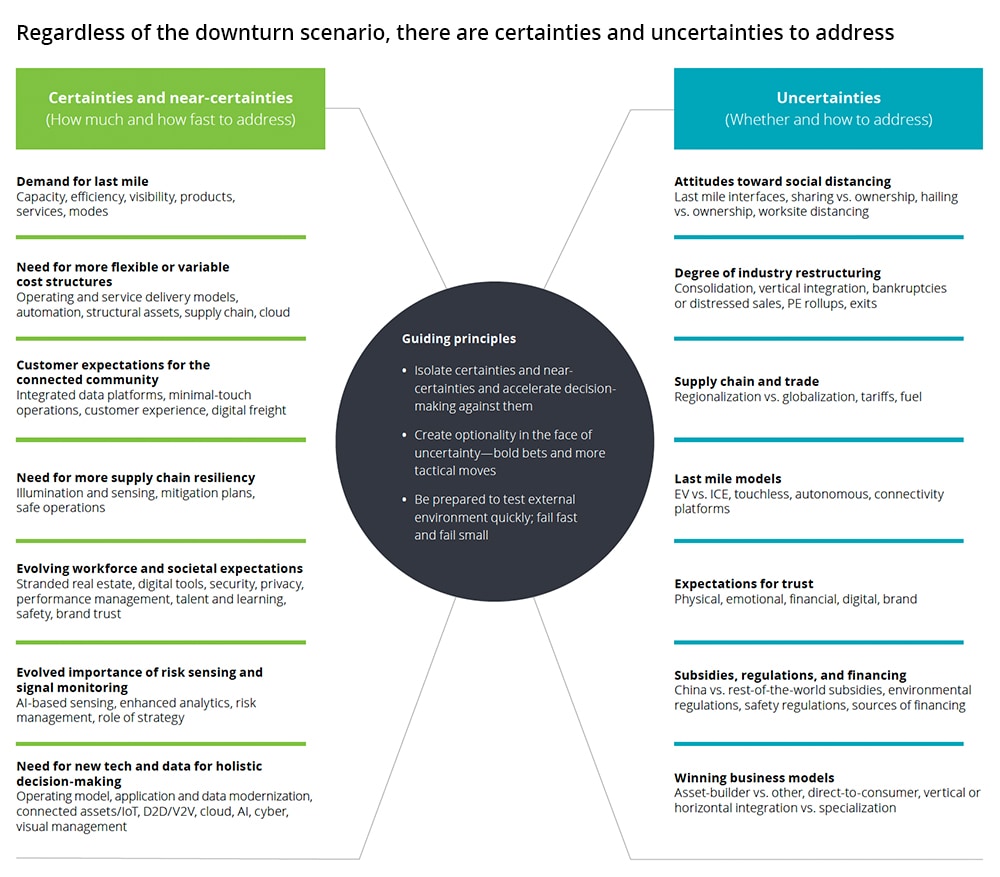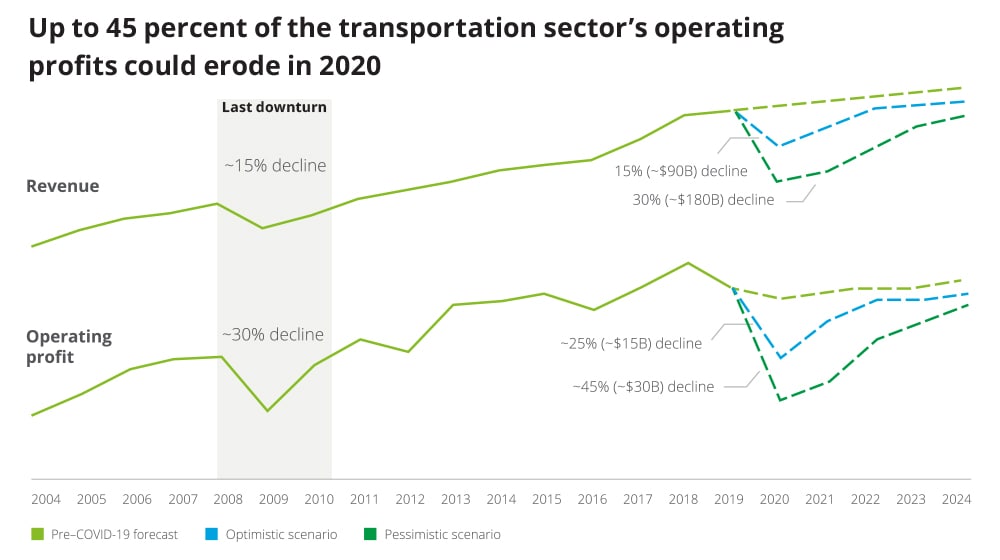Finding opportunities in today’s transportation industry has been saved

Perspectives
Finding opportunities in today’s transportation industry
An analysis of future trends in the sector
A crucial element in the global movement of goods and people, the transportation industry is hurting right now. As company leaders work to effectively respond to crisis and build transportation industry resilience post–COVID-19, they are presented with a dramatic opportunity to remake their organizations and perhaps the sector as a whole.
Explore content
- The challenges of building transportation industry resilience
- New pressures, old opportunities
- The COVID-19 crisis isn’t the only thing, but it is the first thing
- Moves you should not ignore and likely will not regret
- Transforming business models to leap ahead post–COVID-19
Building a path to transportation industry resilience
The transportation industry had trouble brewing before anyone heard of COVID-19. The pandemic has simply taken just a few weeks to expose underlying inefficiencies the sector has never fully addressed. There is an opportunity for many who choose to address these.
So what is the course forward in a post–COVID-19 world? Some may call it a win just to survive this downturn by addressing immediate liquidity challenges. But companies that have more financial and strategic freedom—and that have the ability and willingness to challenge sector issues that have existed for years—may find ways to thrive and perhaps even redefine the sector as a whole. Regardless of the pandemic’s severity, there are certainties to address, and the current environment presents an opportunity for some companies to leap ahead. Here we provide the outlines of an approach for companies to consider as they chart their path to both recover from the COVID-19 crisis and thrive beyond.
New pressures, old opportunities
Deloitte estimates that by the time 2020 ends, up to 45 percent ($30 billion) of the transportation industry's operating profits could be destroyed. That’s the equivalent of one-quarter of its companies’ operating profits. But the transportation industry was under pressure well before COVID-19. COVID-19 has simply exposed longstanding challenges, such as the following:
- Customer expectations for speed, and service and the implications for localized distribution
- Inefficiencies and congestion from inflexible networks and evolving trade patterns
- Fragmentation of supply in a sector that has rarely consolidated
- Lack of investment in new technologies to connect, learn, predict, and automate
- Shifting talent models from retiring workforce to the gig economy
- Disruptive entrants that are taking advantage of the inefficiencies to displace others
The combined impact of these problems is a five-year sector aggregate return of 19 percent, compared with 57 percent for the S&P 500, and a “revenue multiplier” (or enterprise value / revenue) lower than many other industries—meaning that investors are not willing to pay as much to invest in transportation as they are willing to pay for a stake in many other sectors.
The COVID-19 crisis isn’t the only thing, but it is the first thing
While the numbers may be discouraging, the transportation industry is essential to the global economy, and the performance of some companies has been superb despite the sector’s underlying challenges.
So how can companies respond? Some strategies apply to all, while others depend on the strength of each company’s current position—and may spell the difference between merely surviving the crisis and emerging from it stronger than before.
Moves you should not ignore and likely will not regret
There is much debate regarding downturn scenarios and their implications. But regardless of how severe one believes the pandemic’s impact will be, there are certainties any company should address—the only questions being how much and how fast. There are also known uncertainties—the questions being whether and how to address these. The below illustrates these certainties and uncertainties.

Transforming business models to leap ahead post-COVID-19
Some companies in the sector will have sufficient financial and strategic flexibility to “take advantage” of the COVID-19 crisis and leap ahead competitively. But how much inorganic movement will take place in the sector, and in what form? That’s a question whose answer may depend on severity of the downturn. “Leaping ahead” can take many forms, but for those with the will and the way, there are multiple opportunities in distressed markets.
Transforming business models is one of the few actions that can sustainably lift stock prices (and valuations) out of the constrained range many transportation companies have experienced over the past years. Our research has demonstrably shown that the capital markets value companies within each of these four models very differently. The figure below illustrates our research applied to the transportation industry.

Transforming business models is not for the faint of heart, but it is an option for those with the ambition and the wherewithal to fundamentally shift company performance.
Charting a path to transportation industry resilience
This is a challenging time for all. Some companies will fall back on the old ways of operating. Some will have the appetite and the means to incrementally improve their performance. Others will see this crisis as an opportunity to take head-on the long-standing inefficiencies in the sector. And perhaps a few will forge a fundamental rethinking of their companies or the sector overall. As you chart your path, consider the approaches in this paper to help you emerge from the COVID-19 crisis and thrive beyond.
Recommendations
Understanding COVID-19’s impact on the transportation sector
Managing the crisis: Guidelines for transportation leaders
Understanding COVID-19’s impact on the airline sector
Respond with resiliency: Guidelines for airline executives






